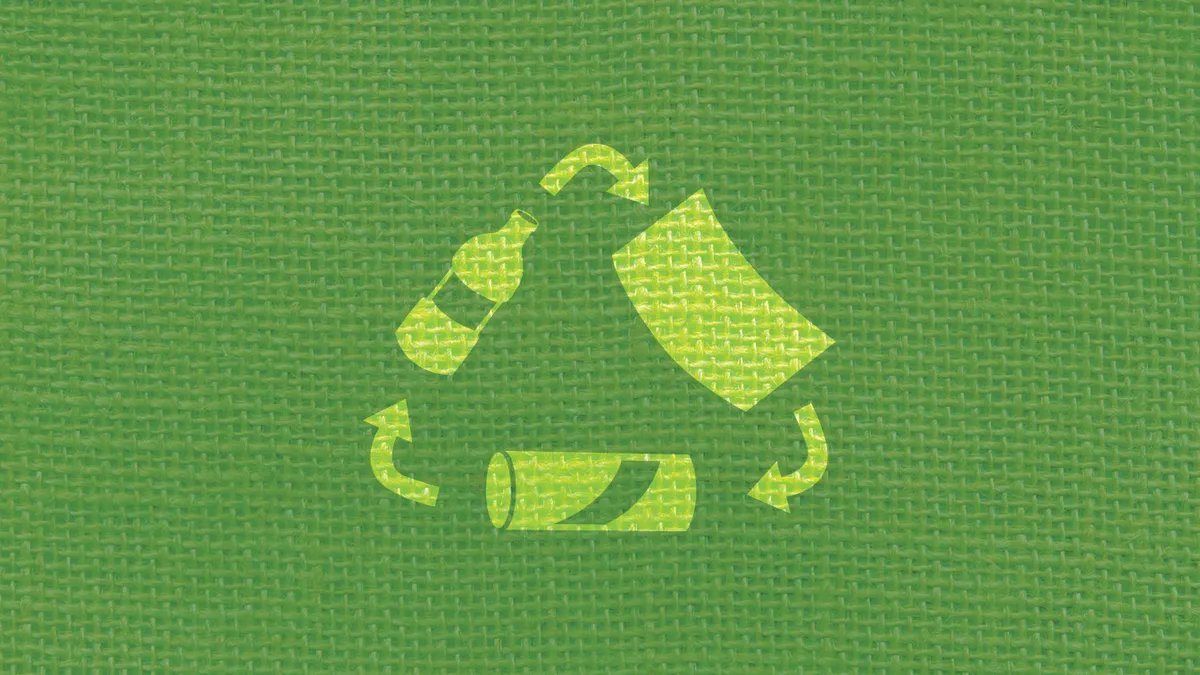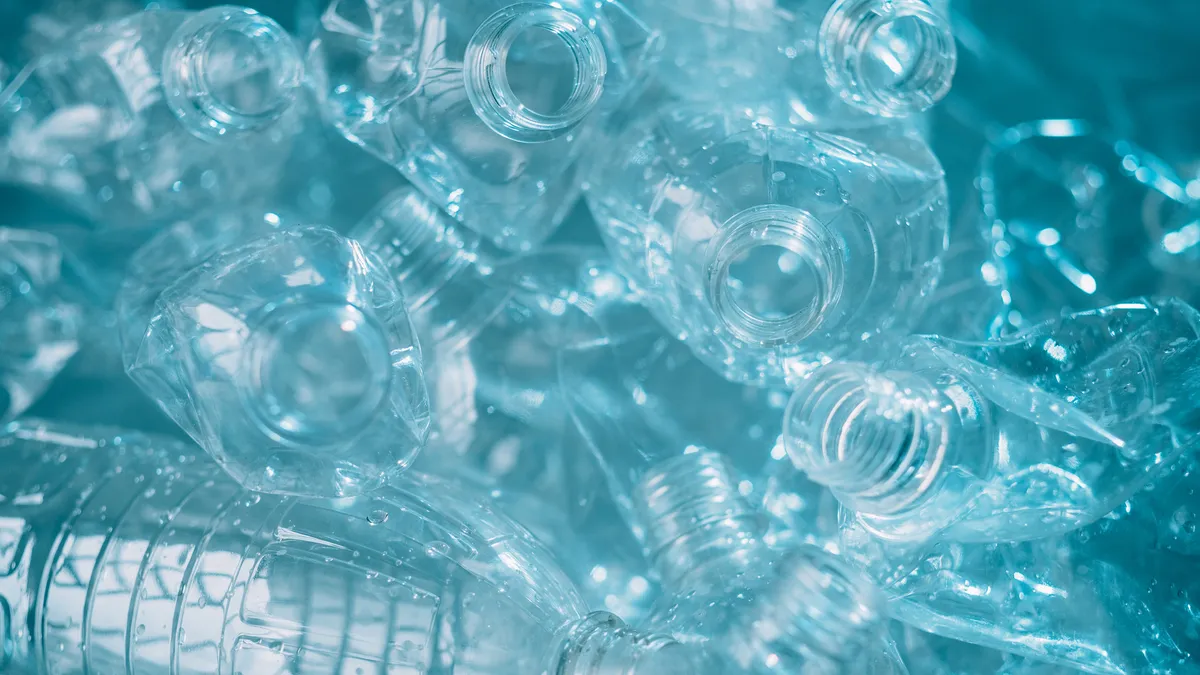The following is a contributed piece and does not reflect an editorial position by Waste Dive. Information on what that entails and how you can submit is available here.
The circular economy is meant to provide an alternative to our current take-make-waste linear economy, which has created unsustainable pressure on our natural ecosystems and resources. Lately, the need to make that change is feeling even more urgent.
According to calculations from this year's Earth Overshoot Day, we would need 1.75 Earths to support our current demands on the planet's ecosystem. And with the middle class expected to double their purchasing power to $64 trillion by 2030 – and a forecasted increase in the world’s population by 2 billion by 2030 – creating a more sustainable economic model seems critical.
The key tenet of the circular economy is to build a production model that is decoupled from virgin resource use. Strategies to support this decoupling include promoting service, repair and remanufacturing business models to extend product utilization and product life. We must also build out recycling and manufacturing infrastructure to process and recirculate materials once products have reached the ends of their useful lives.
From a policy perspective, a key principle of the circular economy is the idea of extended producer responsibility (EPR). Under this concept, manufacturers are responsible for the collection, disposal and processing of their product or packaging.
For materials or products that have little resale value, proponents of EPR believe properly created programs can be especially useful to incentivize upstream changes in design and material composition. In turn, they see this as establishing a feedback mechanism for companies to create products that are more easily recyclable. Opponents of EPR, mainly manufacturers and brands, view it in a punitive light and argue the policy would impose fees on consumers and create burdensome restrictions. This debate is gaining increasing attention at both the state and national level, but consensus is still hard to find.
In the meantime, however, there are businesses that view voluntary forms of EPR as a strategic asset. Armstrong and Netafim are two such companies that have created long-running materials recovery and recirculation programs before the current concept of a circular economy was even invented.
Armstrong Ceiling Recycling Program
Armstrong's initiative is the first and longest running ceiling recycling program in the industry, celebrating its 20th anniversary this year. The company was recently selected as the Upcyclers Network Closed Loop winner in the B2C category for its take back program, in which recovered ceiling panels are returned to the closest Armstrong Ceilings plant and upcycled into new ones.
“Our impetus for creating this program in 1999 was a request from one of our largest customers. They were looking for alternatives to landfill disposal and after doing some investigation, we realized that we had the ability to reuse the material," said Anita Snader, environmental sustainability manager for Armstrong. "Our first ceiling recycling customers were motivated by their own corporate sustainability goals. Additionally, the creation of LEED has helped incentivize more customers to consider our recycling program and support the demand for our ceiling panels with closed-loop recycled content.”
Since its inception in 1999, Armstrong has recycled over 200 million square feet of used ceiling panels, saving more than 1 million tons of virgin raw materials and preventing more than 100,000 tons of construction waste from being disposed.
Even still, Snader believes the program has the potential for much higher impact. “Our greatest challenge has been awareness and adoption, and changing the interior deconstruction process to recycle ceilings versus sending them to a landfill. As the circular economy concept gains popularity, we continue to create more awareness around the benefits of our program and encourage use by our customers.”
Netafim USA
Netafim USA is a drip and micro irrigation manufacturing company that has also been a leader in viewing its end-of-life product as a resource. The company's take back and recycling program was spurred by a desire to include recycled content in its products to help customers meet LEED certification requirements as well as to meet their own sustainability goals.
In 2007, after spending several years on R&D for incorporating recycled tubing into new products, the company created a separate subsidiary – Netafim ReGen Recycling – to operate its recycling and processing facility. Just this May, Netafim ReGen Recycling received a $2.1 million grant from the California Department of Resource Recycling and Recovery (CalRecycle) to expand its collection footprint.
“Netafim takes its environmental goals and responsibilities very seriously and is committed to creating a sustainable supply chain. Not only does our recycling program reduce burdens on California landfills, but it also significantly reduces greenhouse gas emissions and relieves our clients of the costs of product collection and disposal,” said Luke Hoestra, field recycling program manager for Netafim USA. “The CalRecycle grant that we received is exciting in that the state is recognizing efforts from business to help with landfill diversion and recycling, but we still need additional market driven demand for our products that contain post-consumer resins (PCR). The more demand there is for these PCR products, the more used product we can recycle.”
To date, Netafim has collected and diverted close to 100 million of pounds of drip tubing from disposal. With the planned expansion, Netafim intends to collect and pelletize an additional 9,612 tons per year of used irrigation tubing and create 15 additional jobs.
Take back goes mainstream
More recently, voluntary take back programs from consumer brands have increased in popularity. High-profile comapnies including H&M, Levi’s and Adidas now have programs that involve vouchers and other incentives for participating consumers. Patagonia even offers a second life for its products through repair and deconstruction. Other consumer goods brands have followed suit with return programs for items such as razors made by Gillette razors and disposable contact lenses from Bausch + Lomb and Johnson & Johnson.
As with Armstrong Tile and Netafim, these consumer-facing take back programs were also driven by customer demand. The fashion industry has has come under scrutiny for its environmental footprint and take-back programs offer customers an opportunity to recirculate and recycle their clothing. (Although some argue the impact and messaging behind these programs is misleading.) Programs for single-use products such as razors and contact lenses fit into the pattern of assuaging customer concerns around plastic pollution.
While the EPR debate continues to be fought in legislatures across the country, these examples may signal a growing shift in consumer expectations around producer responsibility.
For some companies, take back programs may be the cost of doing business. For others that can innovate to re-incorporate these materials back into their supply chain, take back programs have proven to be a smart business strategy that can develop resource resiliency as well as customer loyalty.
Gina Lee is founder of the Upcyclers Network, which was founded to challenge society's reliance on natural resource extraction and build a sustainable economy where waste is simply a resource out of place. She has over 15 years of experience working in corporate social responsibility and social impact in multiple countries, including with the Aspen Institute, the American Sustainable Business Council and the Los Angeles Cleantech Incubator.






















